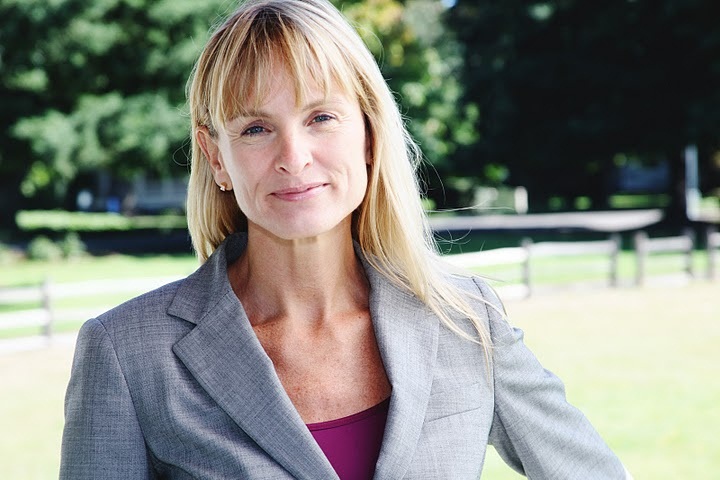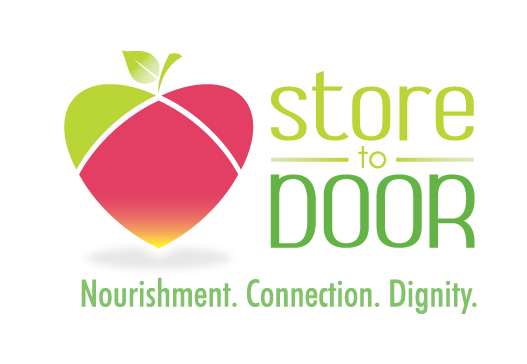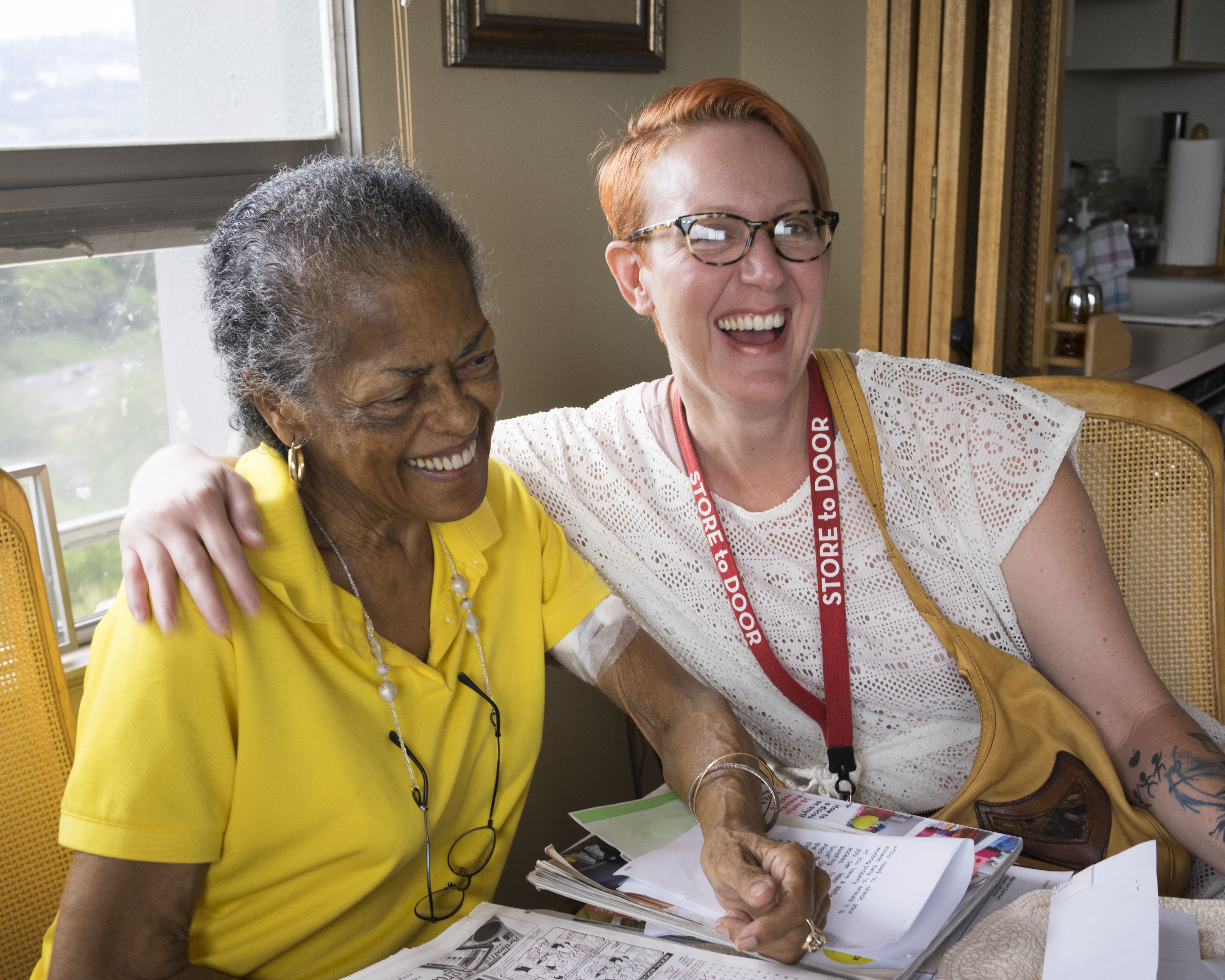AARP Hearing Center

What happens when you can no longer drive or get out of the home? What happens when doing the simple things that help us remain independent, like getting to the store for weekly groceries, becomes a major challenge? According to AARP research, 90% of people ages 45+ say they want to remain in their own home as long as possible. But being able to live independently is a challenge for many older adults and people with disabilities. That is where an organization like Store to Door comes in! AARP Oregon has been working with Store to Door’s Executive Director Kiersten Ware and her team this year on our food security outreach efforts and we have become great fans of their work. We asked Kiersten about her non-profit in a recent interview.
Kiersten, tell us about yourself, your background and what keeps you up at night or gets you out of bed in the morning.
I have more than 20 years of experience as a non-profit leader and community planner in the field of aging. I developed and implemented the award-winning ElderFriends volunteer-based friendly visiting program in three U.S. cities and I have a Master’s degree in Gerontology. I’m energized by work that promotes positive aging, creative solutions for aging-in-community and multi-generational engagement. My affinity for older adults came from my personal experiences with my own grandparents. They gave me the gift of their time and attention. By listening to Elders, we receive the benefit of their significant experience in the world.
What keeps me up at night? Ageism and the marginalization of older adults. We live in an age-segregated society and those who are home-bound are practically invisible. Luckily, people with a strong affinity and reverence for older adults find programs like Store to Door.
What gets me out of bed in the morning? I’m inspired by Store to Door’s dedicated staff and volunteers and their commitment to creating meaningful connections with Elders.
How would you describe the work of Store to Door and how does it work?

Store to Door supports independent living for Portland area seniors and people with disabilities by providing a low-cost, volunteer-based grocery shopping and delivery service. The goals of our program are to help vulnerable seniors and adults with disabilities maintain their independence, increase their social supports and have access additional low/no-cost services that support aging-in-place. Our vision is for the Portland metro area to be a community where every senior and person with a disability is nourished, cared for and able to age in the setting of their choice.
Each of our clients receives a weekly phone call from the same volunteer order-taker who records the client’s order and checks on their well-being. Volunteers and staff shop and make deliveries. The same delivery driver always visits the same client, ensures the order is correct and helps put groceries away. More than just a delivery service, our order takers and delivery drivers are often the only regular callers and visitors these isolated individuals have. They take time for a friendly visit and check to make sure the client is safe. Our trained volunteers provide personalized service that builds trusting relationships. This allows us to identify and respond to health and safety concerns that might otherwise go undetected.
Can you tell us more about your clients and volunteers?

In 2016 Store to Door will serve 580 low-income seniors (ages 65 and over) and people with disabilities. Nearly 20% of our clients are over the age of 90, with 76 being the average age. 84% are women and 85% live alone. 100% of our clients have at least one disability and are low-income or unemployed – many live on an annual income of less than $12,000. All of our clients are considered “homebound”: physical or mental limitations make accessing groceries, resources and social supports outside of the home very difficult or impossible. Due to the combined barriers of age, disability and poverty, without Store to Door our clients would be at high-risk for hunger and isolation.
Approximately 600 active volunteers supported Store to Door’s shopping and delivery service in 2015. Volunteers help in a variety of ways, as order takers, shoppers, delivery drivers, friendly visitors, and through administrative support. The average Store to Door volunteer is 41, and 8% are over 65 years of age. The majority of our volunteers are initially drawn to our mission and most continue because they enjoy the staff, volunteers, and clients. 86% volunteer more than once and 16% have supported Store to Door for more than 5 years.
As a member of the Older Oregonian Hunger Coalition and from your vantage point as the Executive Director of Store to Door, what do you see are the key challenges related to hunger and older adults?
The growing need. In 2012, 2.8 million households with seniors experienced food insecurity. The number of people 65 and over in the Portland region is projected to double from 190,262 in 2010 to 394,406 in 2030 and 1 in 6 seniors will experience hunger. Access is critical when it comes to food security. Store to Door’s clients experience barriers due to age, mobility limitations, physical disabilities, transportation, income limitations and isolation that make access to food more challenging.
What is an opportunity or innovative solution you would like to see implemented? Community-based, in-home services like ours are considered the best practice to protect vulnerable Elders from hunger, isolation, and institutionalization. While in 2016 we will serve around 580 individuals, local census analyses show that there are at least 3,500 people in our service area who need us. By 2025, that number is projected to increase by one-third. We are developing a measured strategy to double our client base by 2019, with the hopes of making Store to Door’s life-saving service available to everyone who needs it by 2025.
Isolation is an issue we often see among older adults and is something that many of your clients may be contending with. What can people of all ages do to prevent senior isolation?
We must address social isolation as individuals, as organizations and as communities. On an individual level, we can volunteer. This not only benefits the individuals who are unable to participate in activities outside of their homes, it also benefits the volunteer in terms of their own increased socialization and health. Those who volunteer have lower mortality rates, greater functional ability, and lower rates of depression later in life.
Store to Door is one of a number of social service organizations here in Portland that are hard at work reducing isolation and providing vital services for elders. Villages NW embraces the strategy of bringing services to people, rather than moving people to services, by helping to organize grassroots support networks within established neighborhoods. Low-cost transportation options like Ride Connection provide accessible transportation for those in need.
The Age-Friendly Portland movement is working at a community level to ensure that people of all ages have a livable built environment that supports engagement and being connected. They are committed to providing affordable, accessible, and well-located housing; promoting opportunities for older adults to have volunteer or paid roles in the community and supporting multi-generational civic engagement activities.
All of these approaches help reduce and prevent isolation.
If I am not mistaken, a majority of your clients are women. Do you have any unique insights about women and aging that you would like to share with our readers?
Yes, 84% of Store to Door’s clients are women. According to the 2014 US Census, older women have a higher poverty rate than men. More women than men live alone, and that proportion increases with advanced age: 70% of single dwellers over 65 are women, and older persons living alone are more likely to be poor than those living with their families. Store to Door doesn’t have criteria around income, gender or household size, yet these demographic trends help to explain why women are using our service most. Women live longer lives in a disproportionately poorer state and tend to be more alone than men. Minority women are impacted even more by poverty.
Any last words before we end the interview?

People often ask me “Why not just use a regular grocery delivery service?” I respond that Store to Door offers so much more than any ordinary delivery service can. Unlike for-profit grocery delivery services, we charge only 10% of the grocery total to accommodate the needs of low income clients. The remainder is offset through charitable contributions. And Store to Door volunteers do much more than deliver groceries. Our volunteers call clients weekly and know them by name. Many have established ongoing relationships, knowing what they like, talking through product options and catching up as friends.
Our dedicated Store to Door Volunteers lend their support in roles they find the most fulfilling, contributing approximately 15,000 hours of service in 2015 (the equivalent of about $338,250 of paid time). Why do we do it? The overwhelmingly positive responses of our clients say it all: “I used to go a couple of days without eating,” said one Store to Door client, “and was too ashamed to ask for help. Store to Door has changed my life.”
If you are in the Portland area and are interested in volunteering with Store to Door, you are invited to join us! To get started, just visit our website and submit your online form: www.storetodooroforegon.org/volunteer































































